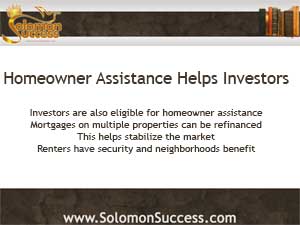 Justice and fairness re key virtues in King Solomon’s proverbs, and these qualities are at the center of his sayings about right living. “I walk on the way of justice,” he says in Proverb 8:20, “In the midst of the paths of judgment.” Walking in the way of justice and equality in today’s world of investing in income property involves equal opportunities for all homeowners, residential and investors alike, to take advantage of the homeowner assistance programs offered by lenders to bolster the housing recovery.
Justice and fairness re key virtues in King Solomon’s proverbs, and these qualities are at the center of his sayings about right living. “I walk on the way of justice,” he says in Proverb 8:20, “In the midst of the paths of judgment.” Walking in the way of justice and equality in today’s world of investing in income property involves equal opportunities for all homeowners, residential and investors alike, to take advantage of the homeowner assistance programs offered by lenders to bolster the housing recovery.
The number of single-family homes occupied by renters has been rising steadily since the housing collapse of 2008. As we’ve noted in previous posts on the topic, former homeowners who lost homes in the collapse have helped to fuel the upswing in rental housing, along with other non-traditional renters such as retirees and those under 30 who aren’t very interested in buying the typical single family dwelling. And a hot rental market is also good for investors who have little trouble finding tenants for their investment properties and keeping a cash flow coming in from them.
But it’s less well known that in some markets landlord/investors may also be struggling to keep up with the mortgages on their rental properties. In areas where economies are depressed and jobs are scarce, keeping properties rented may be harder, and tax deductions for passive income loss don’t always apply. Some investors bought up low-cost proprieties when the housing market was booming, and are now stuck with those homes – unable to sell them, but also unable to use them to meet the monthly mortgage costs.
Refinancing options and other kinds of homeowner help for investors has been limited, focusing instead on averting foreclosure for residential homeowners. Some lenders require investors to meet more stringent criteria than residential borrowers, and may charge higher interest rates.
But some major lenders are recognizing that stabilizing struggling landlords can also stabilize the housing market in that area by keeping renters secure in their dwellings and keeping houses from standing vacant, subject to deterioration and vandalism. In 2012, the Home Affordable Refinance Program, or HARP, opened its doors to investors with a high loan to value ratio, as well as to residential homeowners.
The revised HARP guidelines make mortgage assistance available to individual investors who have been turned down for refinancing by other participating lenders. And some added provisions in the new version of HARP, or HARP 2.0, are aimed directly at investors. While the original version of HARP restricted financing to owners of just one owner-occupied home, the new guidelines allow borrowers to own and refinance more than one property. The new HARP also allows unlimited loan-to-value and access to a wider variety of lenders who administer the program for Fannie Mae.
Although the image of the struggling homeowner barely staying afloat is the face of the housing collapse, the recently revised HARP standards reveal that landlord/investors, especially those holding only a few properties, can struggle too. And helping those investing as Jason Hartman recommends helps renters, neighborhoods, and the housing market as well.
The Solomon Success Team

